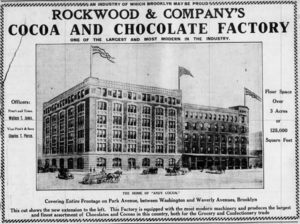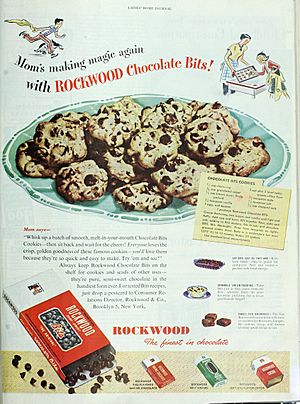- This page was last modified on 17 October 2025, at 10:18. Suggest an edit.
Rockwood & Company facts for kids
Rockwood & Company was a famous chocolate company based in New York City. It made delicious chocolate products from 1886 until 1957. At one point, it had the biggest chocolate factory in New York and was the second largest chocolate maker in the whole United States, right after Hershey's.
The company started in Manhattan but later moved its main factory to the Brooklyn neighborhood of Wallabout. This factory grew so big it took up most of a city block! In 1919, a fire at the factory caused a huge flood of melted chocolate in the streets, which attracted many excited children. Rockwood & Company eventually sold its factory to the Sweets Company of America in 1957. This company then made Tootsie Rolls there until 1967. Today, the old Rockwood factory building is a historic landmark and has been turned into fancy apartments.
Contents
What Rockwood & Company Made
Rockwood & Company was started by Wallace T. Jones and W. E. Rockwood in 1886. They first had a factory in Manhattan before moving to Brooklyn in 1904. The company took raw cocoa beans and turned them into all sorts of chocolate treats.
They made many different products, including:
- Chocolate coatings
- Chocolate bars
- Cocoa powder
- Baking chocolate
Rockwood & Company might have been the first company to bring chocolate sprinkles to the United States around 1915. They called them "Decorettes." Later, one of their most popular products was chocolate chips, which they sold as "Chocolate Bits."
How Rockwood & Company Grew
The company's leaders worked hard to make it successful. In 1923, William M. Evans became the president. Later, in 1933, Wallace Thaxter Jones, the son of one of the founders, took over as president.
In August 1937, about 1,000 workers at the factory went on strike for eleven days. This happened after other chocolate workers in Pennsylvania had also gone on strike. A few months later, Rockwood & Company helped set up a new way to sell products. They made sure their "Pecan Feast" chocolate bar would always be sold for at least 5 cents.
During World War II, Rockwood was one of the companies that supplied chocolate to the military. This chocolate was important for soldiers.
New Ideas and Challenges
After the younger Wallace Jones passed away in 1946, H. Russell Burbank became the new president. Rockwood & Company used clever ways to advertise their products. They offered $1,000 scholarships to people who won the Pillsbury bake-off contest if they used Rockwood products in their recipes.
This plan worked well! In 1949, a recipe using Rockwood products won a big prize at the Pillsbury contest. The recipe was then printed on packages of both Pillsbury and Rockwood products, helping more people discover Rockwood chocolate.
In 1954, the company faced a challenge when some cocoa beans went missing from the factory. A lot of cocoa beans were reported stolen, which was a big deal because cocoa beans were quite expensive. That same year, the price of cocoa beans around the world went up a lot. This made it harder for Rockwood & Company to make a profit because they were spending more on beans but couldn't raise their product prices.
In 1957, the workers at the factory went on strike again. They were worried about what would happen to their jobs if the company closed down. The very next month, in April 1957, Rockwood & Company's chocolate business was sold to the Sweets Company of America.
The Famous Brooklyn Factory
The main Rockwood & Company factory was located in the Wallabout neighborhood of Brooklyn. This area was a busy industrial hub back then. The original building was built in 1890 for a different company, but Rockwood & Company gradually bought more land and built new buildings.
By 1910, the Rockwood factory was the largest chocolate factory in New York State and one of the biggest in the country. It had more than 125,000 square feet of space for making chocolate!
The Chocolate Flood of 1919
In May 1919, a fire broke out in the factory's shipping area. This is where lots of chocolate was stored in big bags. Firefighters worked for three hours to put out the fire. As they sprayed water into the building, it mixed with the melted chocolate. This gooey mixture flowed out into the street.
The sugar and butter in the chocolate then hardened, blocking the sewers! News of the "ocean of fudge" quickly spread, and many children rushed to the scene. They were excited to see the chocolate flooding the street. Some even tried to taste it! Eventually, school officials were called to round up the "chocolate-gorged truants" and send them back to school.
Later Years of the Factory
In 1938, another fire spread to the Rockwood factory from a neighboring paper company. This fire caused a lot of damage and made thick smoke that made it hard for firefighters to see.
After Rockwood & Company sold the factory in 1957, the Sweets Company of America used it to make Tootsie Rolls. The factory continued to operate for ten more years before closing its doors in 1967.
In 1983, the old Rockwood Chocolate Factory was recognized as a historic place. It stayed empty for a while until 1996, when a company bought it and turned it into fancy apartments. Today, the factory complex is part of a larger historic district in Brooklyn.




